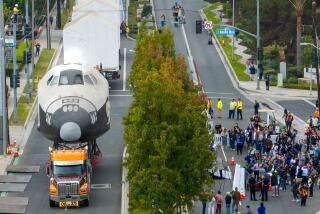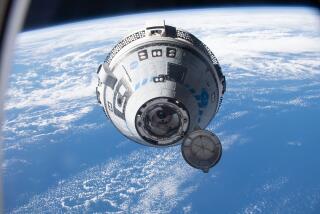Columbia Blasts Into Orbit With Spy Satellite Aboard
CAPE CANAVERAL, Fla. â Columbia rejoined NASAâs fleet of active space shuttles today, blasting into orbit with five astronauts to put a 10-ton spy satellite on a path over the Soviet Union, China and the Middle East.
Columbia, the oldest shuttle, had been grounded 3 1/2 years while it was stripped and overhauled from its toilet system to its outer skin. Its performance during the countdown and at liftoff was trouble-free.
âAs good as new,â said Bob Sieck, the launch director. âItâs going to be a gem of a vehicle.â
The Air Force, which booked the entire five-day flight from the civilian space agency, would say nothing about the cargo in the shuttleâs 60-foot-long hold. Neither did NASA, which shut down its public announcement network, except for periodic âallâs wellâ reports.
Not a word was heard publicly from the five astronauts, who are commanded by Air Force Col. Brewster Shaw, a veteran of two earlier shuttle flights, including a 1983 trip on Columbia. The other crew members are Navy Cmdr. Richard Richards, Navy Cmdr. David Leestma, Army Lt. Col. James Adamson and Air Force Maj. Mark Brown.
Edwards Landing Sunday
The mission is expected to end Sunday with a landing at Edwards Air Force Base in California about 7:30 a.m. PDT.
The shuttleâs path, almost perpendicular from its seaside launch pad, was a confirmation of pre-launch reports that it would travel on a north-northeast course instead of heading eastward.
The resulting high-latitude orbit takes it over Poland, the Soviet Union, Mongolia, China and parts of the Middle East not normally covered by eastward-bound shuttles. The satellite is designed to take highly detailed photographs of troop movements, military installations and other targets of interest.
Sources close to the program said the satellite can make small adjustments to its orbit, a flexibility that would enable it to respond to changing conditions on the ground.
The cargo bay reportedly holds a package of scientific instruments for military research, possibly for the âStar Warsâ missile defense project.
Last Mission in â86
Columbia, a veteran of seven flights, ended its last mission in January, 1986, 10 days before the Challenger exploded with a loss of seven lives.
âAny time a vehicle is down for a long period of time itâs a little worrisome,â said J. R. Thompson, deputy administrator of the National Aeronautics and Space Administration. âThere were really no problems of any significance. The weather was good to us.â
Columbiaâs return restored the shuttle fleet to three ships. Atlantis is scheduled next for launch Oct. 12, carrying the Galileo probe to Jupiter, and Discovery is scheduled for another military mission in November. A replacement for Challenger, the Endeavour, is to join the fleet in 1992.
Mission control said Columbiaâs trajectory was âright down the middle of the pike,â--a perfect path.
More to Read
Sign up for Essential California
The most important California stories and recommendations in your inbox every morning.
You may occasionally receive promotional content from the Los Angeles Times.










